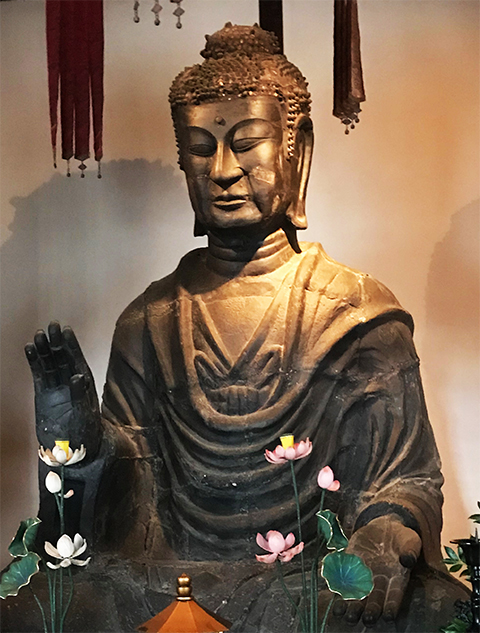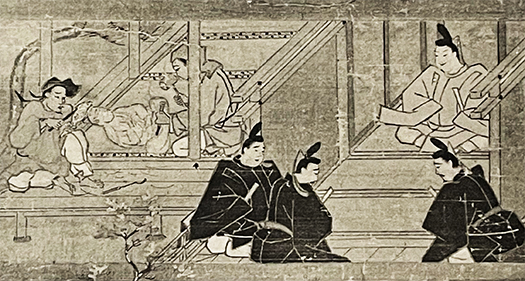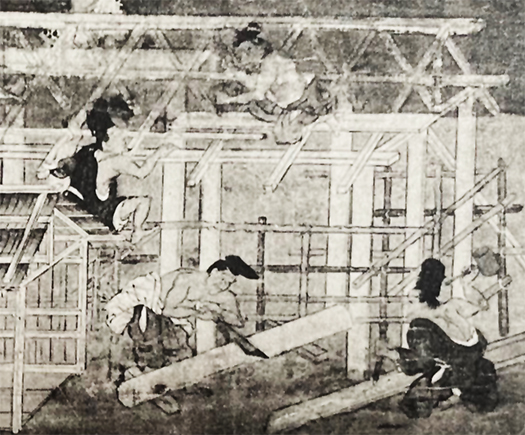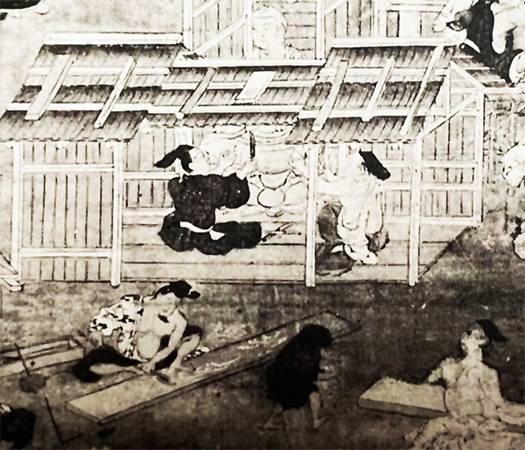

法隆寺宝物館「聖徳太子絵伝」記事、第13回目は飛鳥大仏の制作者・鞍作止利と国家寺院建築の発注者・聖徳太子の機縁について。このシリーズの第一回はこちら→端正なモダニズム「法隆寺宝物館」探訪。
聖徳太子絵伝について掘り下げて見てみてようやく鞍作止利と聖徳太子の直接的な場面と遭遇できた。絵伝探索の迷路の中で発見できた明瞭な図柄。このシリーズ3回目で紹介した記事【聖徳太子がモデル?仏像2体 法隆寺宝物館-3】の増補版でもあります。
上の写真はわたしが飛鳥周辺を散策するようになった最大の吸引力である飛鳥寺の大仏さん。この日本最初期の仏像の制作者が鞍作止利さんで、その作風がいかにもこころに響いてきたのです。その作リ手と聖徳太子との縁起が絵伝のワンシーンとして表現されているのですね。学究ではない凡百の身としては仏教導入最初期の日本社会の空気感に対して確信を持つのに十分と、一種のカタルシスを得られた(笑)。
2枚目の絵では右側に端座する聖徳太子が側近と談笑している。一方、左の別室では止利仏師とおぼしき人物と協力者が仏像の構想模型制作に取り組んでいる様子。丈六仏とは4.8mほどの大きさの「大仏」であり、この絵で表現されているのは、その構想モチーフを人間サイズで表現した試作品・雛形だったと想像できる。発注責任者である聖徳太子はその雛形をもとに作者の鞍作止利と、細部にわたっての綿密な打合せを重ねていた様子なのでしょう。太子の表情がきのう見た動物へのやさしい視線にも似てやわらかく感じる。数寄だったのではないか。
そして仏師の衣類には「異国風の衣装」の特徴があると、1965年奈良国立博物館での「聖徳太子絵伝展」での図録のなかで解説されている。博物館学芸員の専門的な意見として説得力を感じる。仏教導入というものがどんな社会背景であったのか、そのリアリティが伝わってくる。


一方でこの丈六仏を安置する寺院、のちに移転して奈良・元興寺となる飛鳥寺の建築風景も活写されている。この絵からは礎石は使われず、柱は土中に埋め込む掘立工法だったように見える。クギが多用されない「木組み」工法の時代の建築手法の手掛かり。先日紹介した「工人」木造大工職人さんたちの現場労働風景でしょう。
飛鳥寺の創建譚では仏師が作った丈六の大仏をこの建物に入れる段になって、寸法の相互連絡が不足していて「中に入れられません」という建築事故が発生したと伝えられている。それを鞍作止利は絶妙の機転を利かせて解決、問題突破したと言われている。<しかしどうやったの?という方法は伝わっていない(笑)>
また奈良朝のころの絵には大工さんが烏帽子をかぶっているのが多く見られるけれど、これも当時、外来の建築文化ファッションであったとも言われる。こういう部分も掘り下げて見ると面白そうですね。
時空を超える飛鳥の時代のものづくりの様子。共感を持ってその空気感が迫ってくる(笑)。
English version⬇
Shotoku Taishi had Kurusaku Tadatoshi create the Jorokubutsu (Jorokubutsu).
A meeting with the creator of the Jorokbutsu, which can be assumed to be the Great Buddha of Asuka, at the time of its creation. Construction site. Report on Asuka’s “monozukuri” site. ・・・・.
The thirteenth article in the “Shotoku Taishi Era Biography” series from the Gallery of Horyuji Treasures discusses the relationship between Kuramatsuki-Tsumari, the creator of the Asuka Great Buddha, and Shotoku Taishi, who ordered the construction of the national temples.
After delving into the pictorial biography of Prince Shotoku, I finally encountered a direct scene between Kurusaku Toritoshi and Prince Shotoku. A clear pattern found in the maze of pictorial biography search. In the third article in this series [Modeled after Shotoku Taishi? Two Buddhist statues: The Gallery of Horyuji Treasures-3].
The photo above is of the Great Buddha of Asukadera Temple, the biggest draw for me to explore the Asuka area. The creator of this first Buddhist statue in Japan was Mr. Toritoshi Kuramasaku, and the style of his work really resonated with me. The connection between the creator and Prince Shotoku is expressed in a scene from the pictorial biography. As an ordinary person who is not a scholar, I felt cathartic enough to be convinced of the atmosphere of Japanese society at the time when Buddhism was first introduced (laugh).
In the second picture, Prince Shotoku is seated on the right side, chatting with his entourage, while in another room on the left, a person who appears to be a Buddhist priest and his collaborators are working on the ancestral model of a Buddhist statue. The Jorokubutsu is a 4.8-meter statue of the Great Buddha, and we can imagine that what is depicted in this painting is a human-sized prototype or model of the motif that was conceived. It is likely that Prince Shotoku, who was in charge of placing the order, had detailed discussions with the artist, Kuramasaku Tomotoshi, based on the prototype. The expression on Prince Shotoku’s face is soft, similar to the gentle gaze toward animals we saw yesterday. It must have been a sukiyomi.
And the clothing of the Buddhist priests has the characteristics of “exotic costumes,” as explained in the catalogue of the 1965 exhibition of the pictorial biography of Prince Shotoku at the Nara National Museum. I find this a convincing professional opinion from a museum curator. It conveys the reality of the social background of the introduction of Buddhism.
On the other hand, the picture also shows the construction of Asukadera Temple, where the Jorokubutsu was enshrined, and which was later relocated to become Gankoji Temple in Nara. This painting shows that foundation stones were not used and that the pillars were dug into the ground. This is a clue to the architectural technique of the “wooden frame” method of construction, in which nails were not used extensively. This is probably a scene of wooden carpenters, such as the “Koujin” (artisans) introduced the other day, at work.
In the story of the founding of Asukadera Temple, it is said that when the time came to put the Joroku Buddha, which was made by a Buddhist priest, into this building, there was a construction accident because of a lack of intercommunication between the dimensions of the Buddha and the building. It is said that Kurusaku Tadatoshi solved the problem with his exquisite ingenuity and overcame the problem. <But how did he do it? The method of how he did it has not been handed down.
In paintings from the Nara period (710-794), carpenters can be seen wearing crow-shaped hats, which is said to have been a foreign architectural cultural fashion at the time. It would be interesting to delve deeper into this aspect of the art.
The scene of manufacturing in the Asuka period transcends time and space. The atmosphere of the time comes to me with sympathy (laughs).
Posted on 6月 10th, 2023 by 三木 奎吾
Filed under: 住宅取材&ウラ話, 歴史探訪







コメントを投稿
「※誹謗中傷や、悪意のある書き込み、営利目的などのコメントを防ぐために、投稿された全てのコメントは一時的に保留されますのでご了承ください。」
You must be logged in to post a comment.